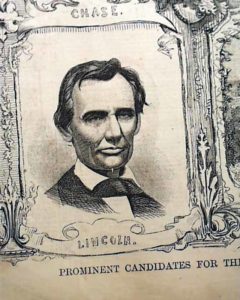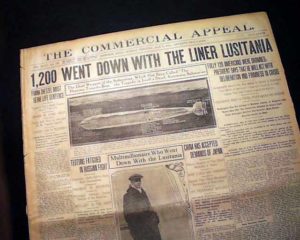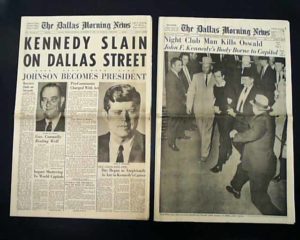Images courtesy of Timothy Hughes Rare & Early Newspapers, www.RareNewspapers.com

Newspapers are what one of my favorite history professors termed “primary sources”: Like diaries, photographs, documents and other artifacts, they are original historical material as opposed to a second- or third-hand description of events plus any number of add-ons and asides, which is what most history books are.
A newspaper – taking into account the speed of communication at the time it was published – is about as immediate as you can get.
Add to that the fact that newspapers, like books, can touch on virtually any collecting field, and you can understand why I like to tell fellow collectors about Timothy Hughes Rare & Early Newspapers (rarenewspapers.com).
Imagine the possibilities …
Let’s say you collect dolls: I searched with the keyword “dolls” and found a Frank Leslie’s Illustrated Newspaper from Dec. 16, 1882, with a multi-image centerfold titled “Visions of Christmas-Tide,” showing Santa Claus giving out doll’s at a children’s hospital. It’s priced at $87.
OK, say you collect Santa Claus – a popular collecting subject. Tim has a whole bunch of examples. A rarer one is a Harper’s Weekly from Dec. 30, 1865 – the first Christmas after the Civil War – with a full centerfold Thomas Nast illustration of Santa titled “Merry Christmas to All.” Price: $117. (A Harper’s Weekly from Jan. 3, 1874, with a full front-page image of Saint Nick sitting on a chimney, titled “Christmas Eve – Santa Waiting for the Children to Go to Sleep,” and which is described as “very displayable,” is $395.) Other vintage issues – Harper’s or other publications – with Santa pics can run even higher or much lower.
Whether you’re into militaria or maritime memorabilia, famous people or infamous crimes, baseball or boxing, African-American history or the Wild West or maritime disasters like the Titanic and the Lusitania – or just old newspapers from a geographical area – you’re bound to find something that will not only interest you but enhance your collection.
What’s more, I’ve known Tim for many years and purchased from him and his people on a number occasions, and I’ve always been impressed by their goods, their excellent customer service and their great shipping.
Tim’s Web site has lots of information on collecting vintage newspapers, but I asked him some basic questions for Northwest Collector readers:
Northwest Collector: What newspapers do you yourself collect? Ones from a specific region or era or pertaining to a certain subject? Or are newspapers in general your collecting “area” and you just like the rarest, most historic items?
Tim Hughes: If I had to be pinned down to a specific era of most interest I would have to say the Revolutionary War, as I am fascinated by its events and how it shaped the future of the United States … and the incredible odds against which Washington and others persevered and ultimately defeated the most powerful military in the world at that time.
But one of the great aspects of this hobby as there are so many possibilities of what to collect – I love to hang on to anything I find unusual, incredibly displayable and particularly rare. My private collection includes a wide range of eras, events, sizes, colors, formats and items of historical significance. Virtually every event in world history over the past 350 years can be found in a newspaper. I love the variety this hobby makes available!
NWC: What are the collecting areas within the hobby?

Tim: The areas of collecting within the hobby are almost endless. Whatever interest one has in history early newspapers will provide a channel for collecting. Many customers will specialize: British history; American wars; significant political events; gangsters and outlaws; significant documents in history (usually published in period newspapers); great disasters; etc., etc. But one of the great appeals is that collecting rare newspapers is often a complementary or crossover hobby to many others: Those who collect autographs will buy newspapers with significant events about those whose autographs they treasure; Civil War buffs will buy Civil War newspaper; political junkies will buy presidential elections, inaugurations and deaths; antique car collectors will buy newspapers with ads of when their pride and joy was first marketed; coin collectors will buy newspapers of when new coin designs were introduced (usually announced in period newspapers); and on and on. Rare newspapers can complement every hobby known to man.
NWC: What are some of the interesting collecting areas of some of your customers?
Tim: See above for some themes of several of our collectors. Others are a bit more focused: only major battles of the Revolutionary War; major battles of the Civil War; any huge, displayable headline; significant events from the city where they happened; one issue for every year from as far back as possible; issues with engravings of eagles in the masthead … One customer only buys newspapers which show “shaking hands” in the masthead: Now, that’s focused!
NWC: How extensive is the hobby of collecting rare newspapers? Are there any other dealers at all who specialize in this?
Tim: Collecting early and rare newspapers is a relatively small and somewhat unknown hobby. We’ve been in this business for 42 years and I’d guess there are no more than two or three thousand serious collectors worldwide. People are absolutely intrigued when they discover we exist and discover that newspapers over 300 years old can be had for less than $50, let alone are available at all. There are three or four others who also sell early newspapers on a smaller scale. We have six full-time and several part-time employees, with an inventory exceeding two million newspapers. I am not aware of any full-time dealers in rare newspapers outside of the United States.
NWC: Do institutions contact you?
Tim: We do have institutions contact us both in terms of buying and selling. Institutions will be in touch when they decide to de-accession issues once microfilmed or digitized, or perhaps when a particular collection is deemed out of scope for their holdings. We also have institutions as customers buying issues which fit their specialty.
NWC: What are the “Holy Grails” of newspaper collecting?
Tim: The “Holy Grails” would be – for most American collectors – period printings of the Declaration of Independence and the Constitution, and ideally in Philadelphia newspapers. They are exceedingly rare and would command six-figure prices should they become available. (A Philadelphia printing of the Declaration of Independence has already brought in excess of $300,000 in a New York auction.)
NWC: Are newspapers ever forged? For example, aren’t there a lot of professionally done reprints in England?

Tim: There are a large number of reprint newspapers on the market today, but I truly believe none were created to deceive. Most are volume one, number one issues which were likely reprinted by their publishers on the 50th or 100th anniversaries, and others are of significant historic events reprinted as promotional giveaways, etc. There are also issues of significant 20th-century events with dramatic headlines which have been reproduced for sale in airports, gift shops and the like. The problem with all these issues is, once tucked away in the attic and discovered years later by others, they are presumed to be genuine and are often offered on eBay as such. It’s a problem, but like any collectible one needs to be aware of the field before investing serious money, and should always deal with reputable dealers who guarantee all they sell.
NWC: What have newspapers been made of over the years, and how perishable are they? Are the high-acid papers necessarily hard to preserve?
Tim: Almost all newspapers of the pre-1880 era had a high cotton/rag content, so even today they remain in surprisingly pliable, well-preserved condition and need little care. To the delight of collectors, such newspapers can be handled and pages turned without concern for causing damage. Most newspapers of the post-1880 period have a much higher chemical and wood pulp content, which allowed newsprint to be made at dramatically lower costs (giving rise to the newspaper boom of the late 19th century and the abundance of “penny newspapers”) but also resulted in such issues becoming brown and fragile within years. These issues are still very collectible but I recommend keeping them in archival quality protective folders for safekeeping. There is supposedly a product which can be sprayed on such newspapers to neutralize the acid and prevent further deterioration, although I’ve never used it. But nothing can “turn back the clock” and make pulpish newspapers new again.
NWC: When was the transition from rag content to high-acid paper in the U.S. and abroad?
Tim: The transition was generally around 1880. Some papers transitioned in the early 1870s, such as the New York Times, and others in the late 1880s, and yet others converted to coated-stock newsprint, which also held photographs and color ink much better than regular newsprint. Harper’s Weekly did the latter.
NWC: I’ve tried to get specific papers for years: They’re really difficult to locate. Where do you get the wide array of newspapers that you sell? You can’t be getting your stock from garage sales and flea markets!
Tim: We actually get our inventory from surprisingly diverse sources. Much of what we currently have is inventory purchased over 40 years ago and which we’ll likely never see again. Some comes from institutions, much comes from private estates and others come as referrals through auctions, sales, etc. Given our Web presence, much material comes as a result of inquiries by those who see our Web site.
NWC: What’s the best way to store newspapers?
Tim: My private collection has issues in individual protective folders, which we created when such a product was not available on the open market; again, the hobby was not big enough to warrant demand. Our protective folders allow newspapers to be very easily placed in and removed from the folders while allowing maximum protection for long-term storage. Easy removal is important, as collectors need that tactile experience of holding the newspaper so as to better “feel a part of its history.” Because of demand by other collectors, we decided to offer them on our Web site, now offering folders in eight sizes for newspapers: RareNewspapers.com/storage_and_display/folders. I also put these protected newspapers in the sturdy newspaper storage boxes available from University Products (UniversityProducts.com), one box per era, which allows a collection to be inventoried and accessed in an easy fashion.
NWC: Now that the Internet is killing printed papers, do you think the latter will become increasingly collectible?
Tim: I believe the long-term demise of hard-copy newspapers will only spur the increased collectibility of early newspapers. This has been the case with almost every collectible on the market: People tend to collect that which no longer exists. I think it is human nature to be intrigued by what is no longer a part of their daily lives, yet which played such an important role in the history of world culture. It’s why we go to museums.
NWC: Do you see any new trends in newspaper collecting?
Tim: Collecting trends tend to follow social interests, which change from time to time. I think there may have been a slight uptick in African-American content and achievements and in women’s interests and achievements, including suffrage pursuits. Also political events, particularly those from the founding years of our federal government. One of the great things with this hobby is, whatever your collecting focus, newspapers remain a gold mine of source material for any personal collection.
